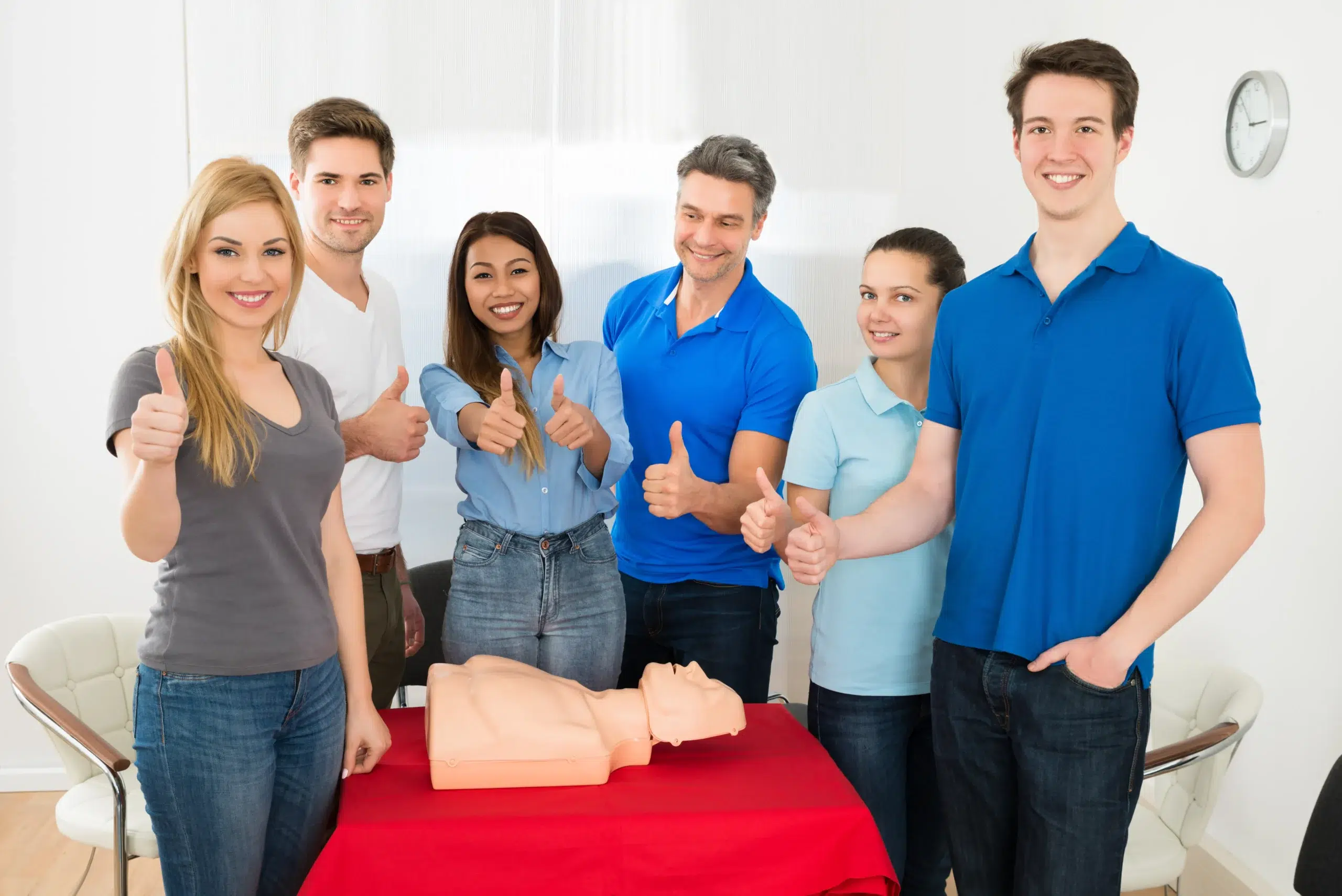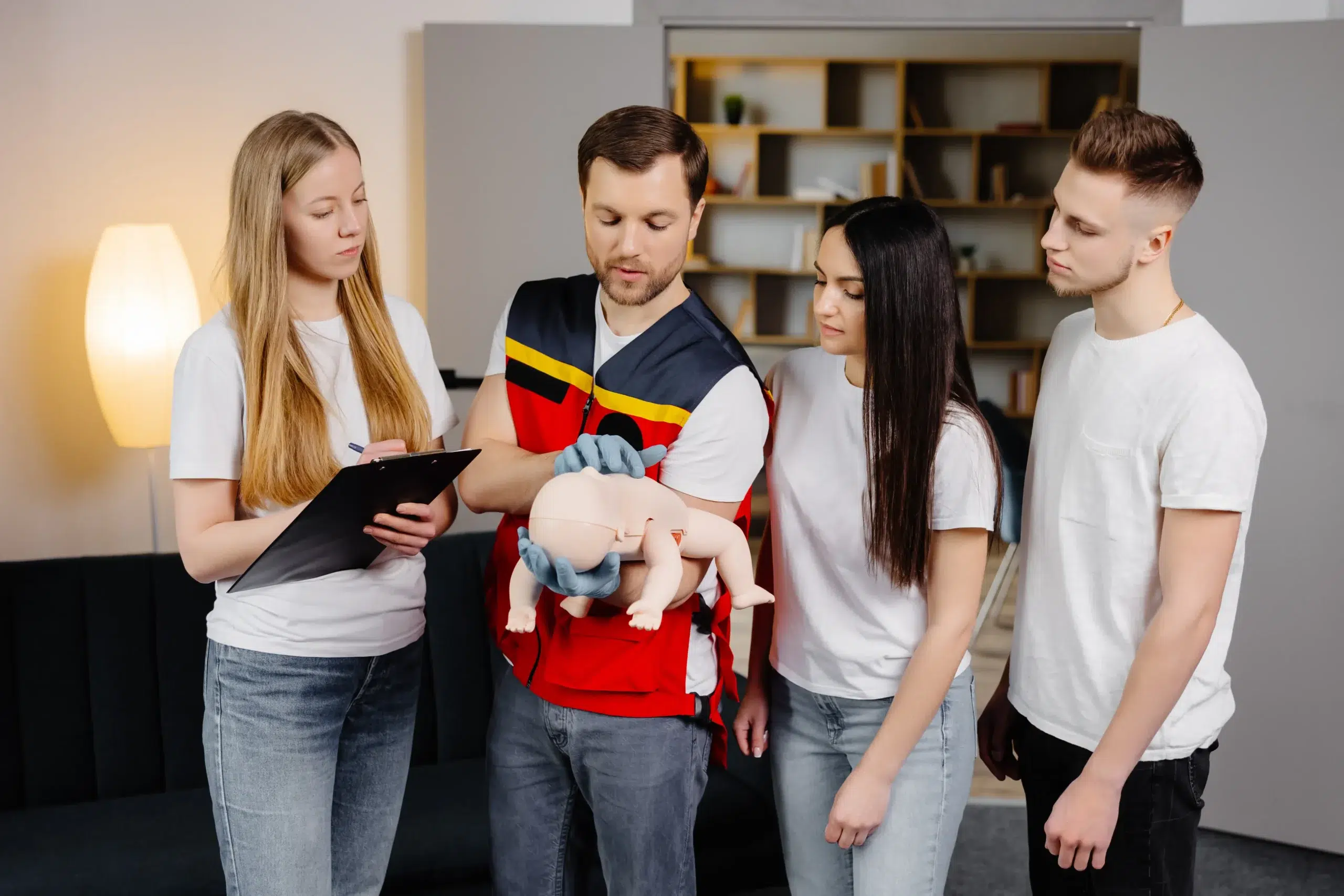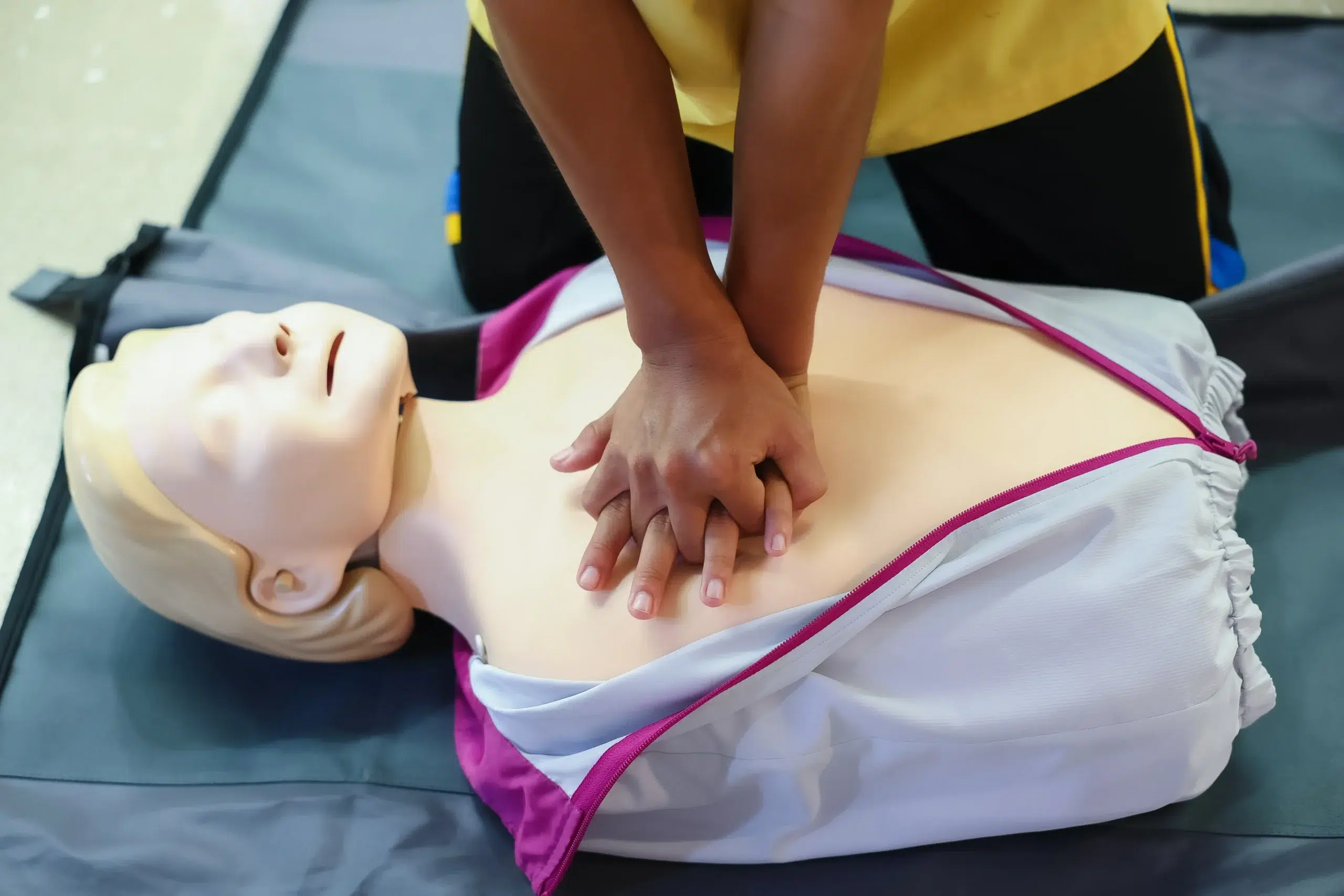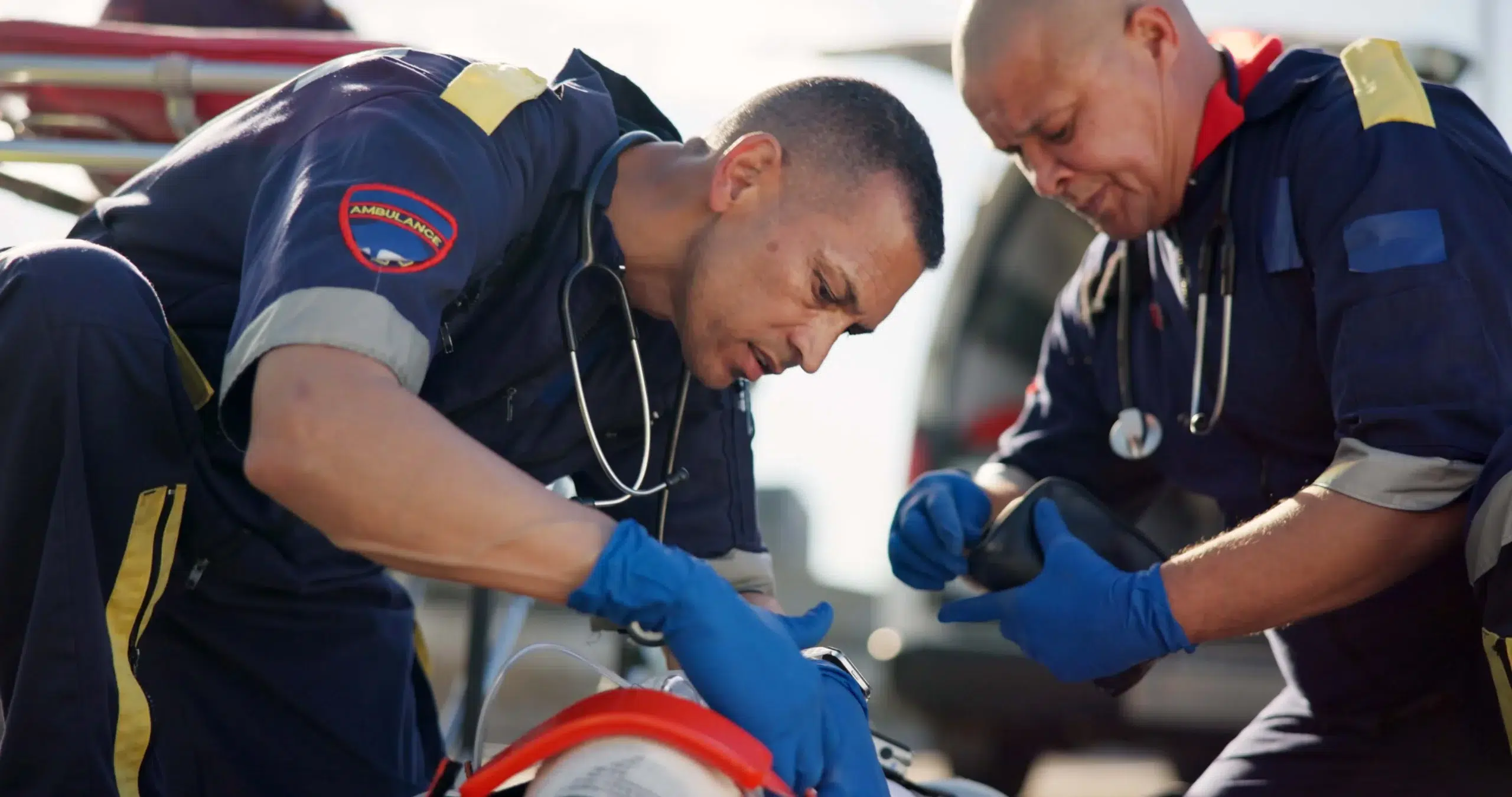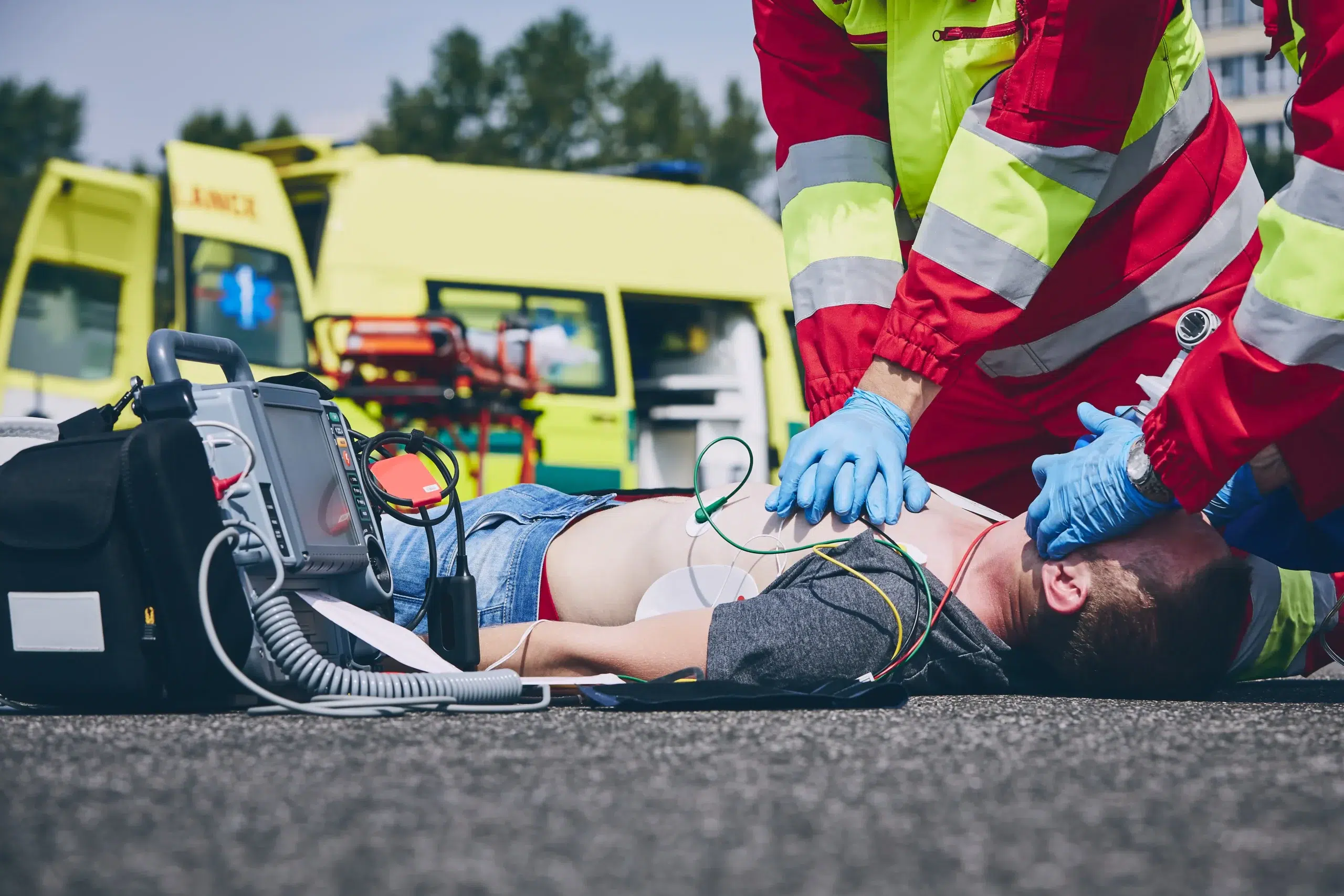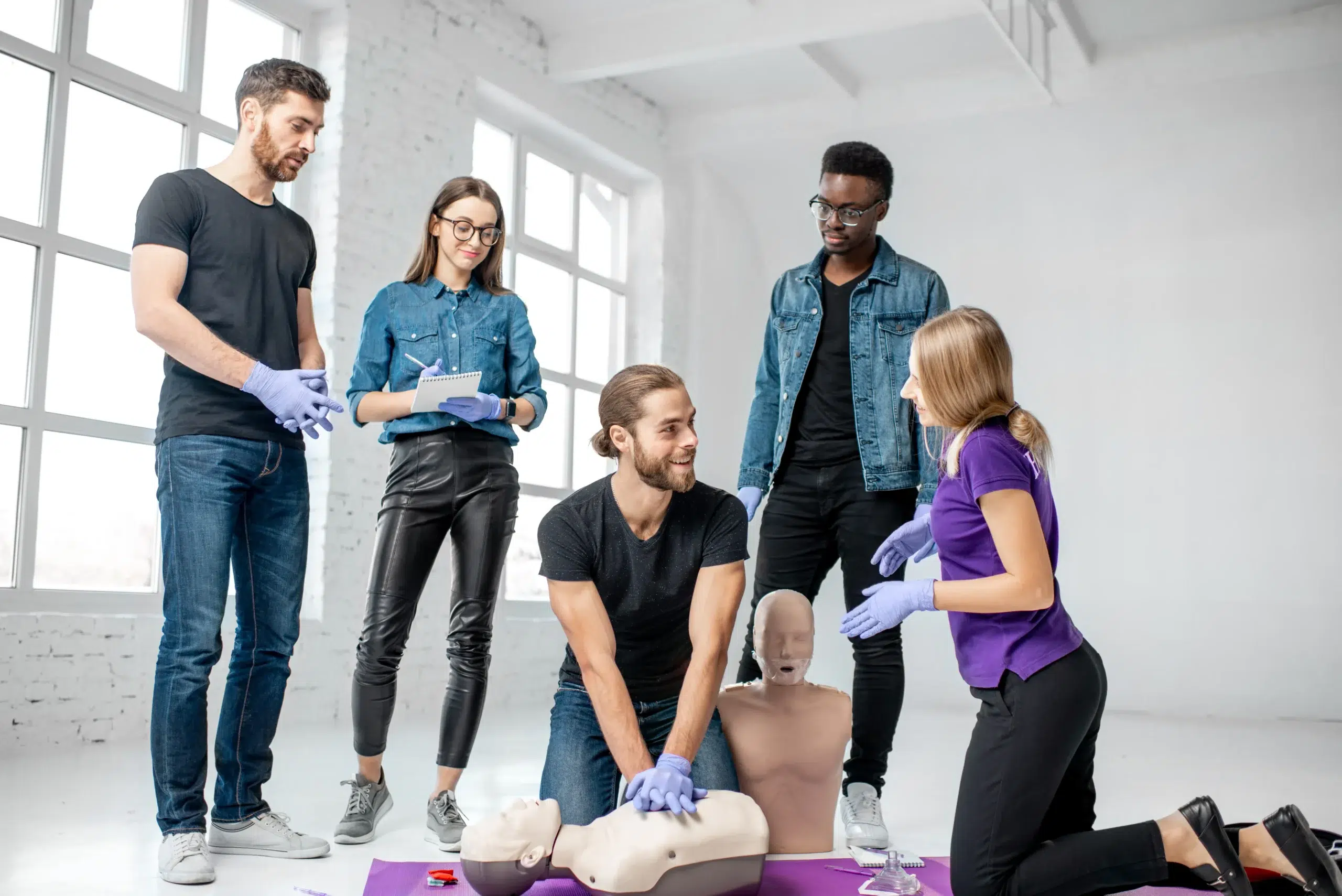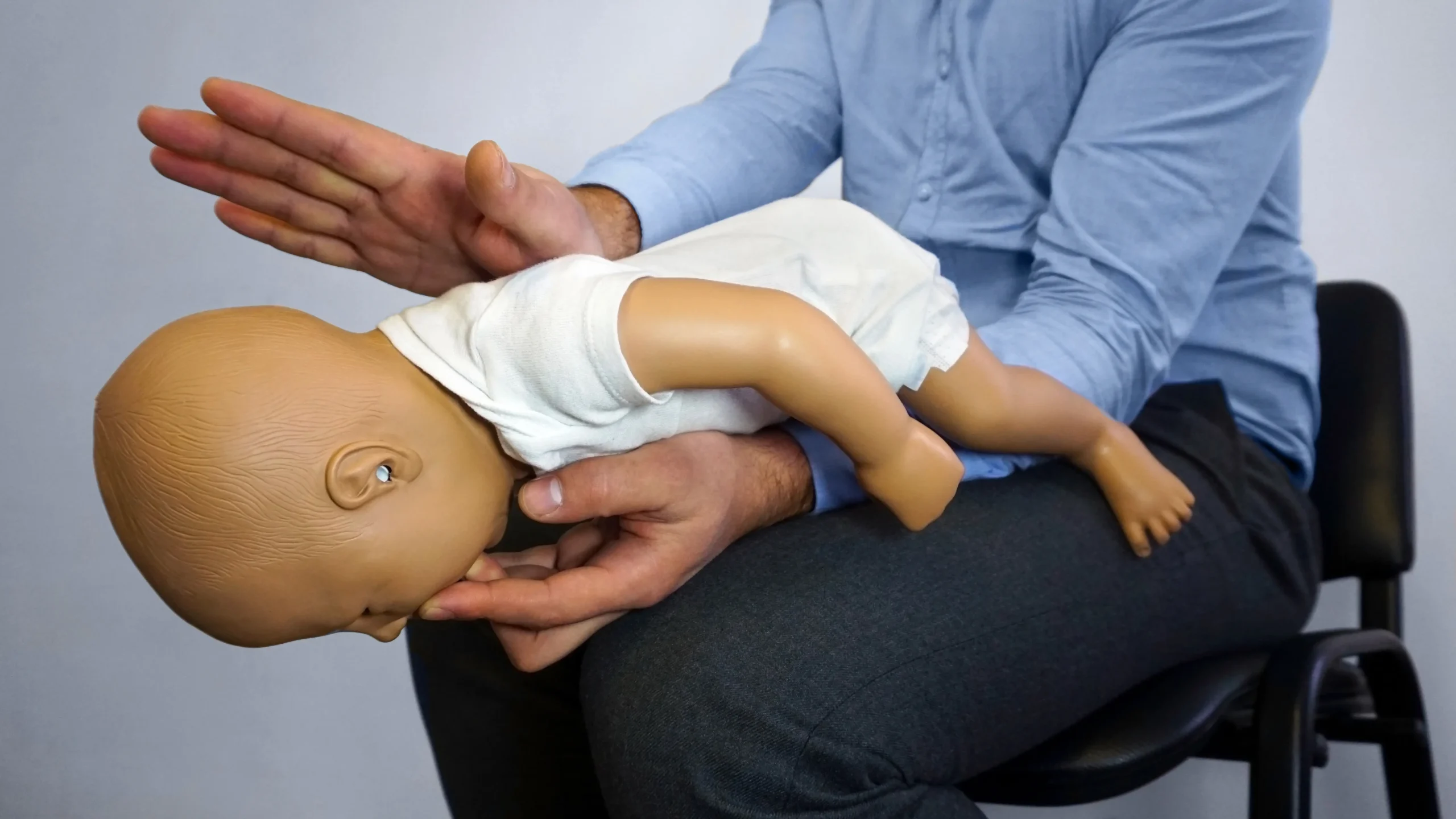Faced with a medical emergency, would you know what to do? CPR, or cardiopulmonary resuscitation, is a life-saving technique that can make all the difference when someone’s breathing or heartbeat stops. This comprehensive guide will walk you through the essentials of CPR, including the various types of courses available, how to find “CPR courses near me,” and what to expect during training. We’ll also cover the importance of maintaining your certification and the many benefits of being CPR-trained, both personally and professionally. Empower yourself with the knowledge and skills to respond confidently in critical situations.
Key Takeaways
- CPR knowledge empowers everyone: Learning CPR equips individuals to confidently handle medical emergencies and potentially save lives, regardless of their background.
- Select the right CPR course: Choose from a range of CPR courses, from basic to advanced certifications like BLS and ACLS, based on your personal or professional needs.
- Stay current with CPR skills: Regular practice and recertification ensure your skills remain sharp and aligned with the latest guidelines, maximizing your effectiveness in emergencies.
What is CPR and Why is it Important?
CPR stands for cardiopulmonary resuscitation. It’s a lifesaving technique used when someone’s breathing or heartbeat has stopped. CPR involves chest compressions, and sometimes rescue breaths, to keep blood flowing to the brain and other vital organs. Think of it as manually taking over for the heart and lungs until professional medical help arrives. Learning CPR is a valuable skill, and not just for healthcare professionals. Cardiac arrests can happen anywhere, and knowing CPR can empower you to make a real difference.
Roughly half a million cardiac arrests happen every year in the US, and bystander CPR can dramatically increase the odds of survival. The American Heart Association emphasizes that immediate CPR can double or even triple a person’s chance of surviving cardiac arrest. This fact alone underscores how crucial it is to get CPR certified. CPR training equips individuals with the knowledge and confidence to respond effectively in emergencies.
High-quality CPR is more than just going through the motions. It’s about performing the technique correctly and consistently improving through practice and evaluation. Whether you’re a healthcare provider, a first responder, or someone with basic first-aid training, maintaining those CPR skills is essential. CPR training not only gives you the skills to act, but also builds confidence and fosters a sense of community preparedness. When more people are trained, neighborhoods become safer and more resilient. Learn more about CPR quality.
CPR Course Options
Choosing the right CPR course depends on your background and goals. Here’s a breakdown of common CPR certifications to help you decide:
BLS for Healthcare Providers
The BLS (Basic Life Support) for Healthcare Providers course is designed for medical professionals like doctors, nurses, paramedics, and other healthcare providers working in hospitals, clinics, or emergency settings. This certification course covers core life support skills for adults, children, and infants, including high-quality CPR, AED use, and effective team dynamics during resuscitation. It emphasizes early recognition and response to life-threatening emergencies.
Heartsaver CPR AED
Heartsaver CPR AED caters to a broader audience, including those outside the healthcare field. This course is suitable for teachers, coaches, childcare providers, workplace safety officers, and anyone who wants to learn essential life-saving skills. Learn more about our CPR and First Aid certification courses. It covers adult, child, and infant CPR, AED use, and how to respond to choking emergencies. Heartsaver courses are a great option for community members and those seeking personal preparedness.
PALS
PALS (Pediatric Advanced Life Support) is an advanced course specifically for healthcare professionals who regularly treat infants and children. This certification delves deeper into pediatric emergency care, covering respiratory and cardiac emergencies, shock management, and post-resuscitation care. PALS builds upon the foundation of BLS and equips providers with specialized knowledge for pediatric emergencies.
ACLS
ACLS (Advanced Cardiovascular Life Support) is another advanced course geared towards healthcare professionals involved in managing cardiovascular emergencies. This certification covers advanced airway management, pharmacology for cardiac emergencies, and effective team leadership during resuscitation. ACLS is crucial for physicians, nurses, and paramedics working in critical care settings.
Find CPR Courses Near You
Ready to learn CPR? Finding the right course is easier than you think. Whether you’re a healthcare professional or want to learn this life-saving skill, there are several ways to find CPR training near you.
Accredited Training Centers
Organizations like the American Red Cross and the American Heart Association offer CPR courses taught by certified instructors. These established providers have training centers across the country, making it convenient to find a class. The Red Cross offers various CPR training formats, including in-person, online, and blended learning. For those in Newark, Fremont, or San Jose, Safety Training Seminars is a woman-owned, AHA Training Center providing various courses, including BLS courses in Newark. We offer a low price guarantee and group discounts.
Search Online
A quick online search can uncover numerous CPR training options. Use search terms like “CPR classes near me” or “CPR certification [your city]” to find local providers. Many training centers have websites with course schedules, pricing, and registration information. You can also find online CPR courses, but make sure they include a hands-on skills session, which is essential for proper certification. We offer CPR and First-Aid certification courses as well as information on RQI classes.
Check Local Community Resources
Your local community centers, hospitals, fire departments, and even some gyms or community colleges may offer CPR training. Check their websites or give them a call to inquire about upcoming courses. Community outreach programs often provide CPR training at a reduced cost or even for free, making it accessible to more people. Community outreach plays a vital role in making CPR training widely available.
Verify Provider Credentials
Before signing up for any CPR course, it’s crucial to verify the provider’s credentials. Ensure the organization or instructor is certified by a recognized body like the AHA. This confirms they meet established standards for CPR training. If you’re considering online CPR certification, double-check its validity. Online certifications are valid if issued by a reputable and accredited organization. A legitimate provider will readily offer this information. Don’t hesitate to ask!
What Happens in a CPR Course?
So, you’ve decided to take a CPR course—great! Knowing what to expect can help you feel prepared and confident. CPR courses blend classroom learning with hands-on practice, ensuring you’re ready to respond effectively in a real emergency. Let’s break down what a typical course entails.
Course Length and Certification Validity
CPR courses generally run between four and six hours, depending on the specific course type and the training center. Safety Training Seminars offers a variety of scheduling options to fit your busy life. Check our BLS courses in Newark for our latest schedule. Once you complete the course and pass the skills assessment, you’ll receive a certification valid for two years. It’s essential to renew your CPR certification to stay up-to-date on the latest guidelines and maintain your skills.
Hands-on Practice and Assessment
CPR courses aren’t just about lectures. A significant portion of the course involves hands-on practice. You’ll work with mannequins to practice chest compressions, rescue breaths, and how to use an AED (automated external defibrillator). Instructors provide real-time feedback to help you refine your technique and build muscle memory. This practical experience is crucial for mastering CPR and feeling confident in your ability to perform it correctly under pressure.
Get Certified
After completing the course and demonstrating your skills, you’ll receive a nationally recognized CPR certification, such as those offered through the American Heart Association. This certification is proof of your training and is often required for certain jobs, volunteer positions, or licensing requirements. Remember, workplace requirements can vary, so it’s always a good idea to double-check with your employer or licensing board to ensure you’re meeting their specific needs. If you’re training a group, Safety Training Seminars offers group discounts. We also have a low price guarantee, so you can be confident you’re getting the best value for your training.
CPR Training Costs
Getting CPR certified is an investment in yourself and your community. Understanding the costs involved can help you plan and find the best fit for your budget. Let’s break down the typical price ranges, explore potential discounts, and look at ways to make training more affordable.
Typical Prices
CPR certification costs vary based on several factors, including the type of course, the location, and the training provider. Basic CPR and First Aid certification typically range from $50 to $150. More advanced certifications, such as ACLS or PALS, can cost more, sometimes reaching $200 or more. These advanced courses often involve more comprehensive training and specialized skills. For example, BLS courses for healthcare providers cover a broader range of life-saving techniques. It’s always a good idea to check with specific providers, like Safety Training Seminars, for their current pricing. You can also compare prices with other providers like the American Heart Association or the Red Cross.
Group Discounts and Deals
If you’re training with a group, such as coworkers or a community organization, you can often find significant discounts. Many training centers offer reduced rates per person for group bookings. This can be a great way to make training more accessible and affordable for everyone. Check out Safety Training Seminars’ group discount page for more information. Some employers even sponsor CPR training for their employees, covering the entire cost. It’s worth checking with your HR department to see if this is an option. This can be a valuable benefit, especially for professions where CPR certification is required or highly recommended.
Financial Aid
While less common for CPR training than for other types of education, some organizations may offer financial assistance or payment plans. This is worth exploring if cost is a barrier. Contacting the training provider directly is the best way to inquire about potential financial aid options or flexible payment arrangements. Don’t hesitate to ask about options like payment plans or scholarships; some training centers may have resources available. Understanding your options and planning ahead can make CPR training accessible to everyone. Remember, the value of knowing CPR is immeasurable – it could save a life. Check out Safety Training Seminars’ low price guarantee to see how they make training affordable.
Benefits of CPR Training
Learning CPR offers numerous advantages, from personal growth to career advancement and community impact. Let’s explore some key benefits:
Build Your Skills
CPR certification courses equip you with practical skills to handle medical, breathing, and cardiac emergencies involving both adults and children. You’ll learn to recognize the signs of a cardiac arrest, administer chest compressions, provide rescue breaths, and use an automated external defibrillator (AED). These are fundamental skills that can make a real difference in life-or-death situations.
Advance Your Career
Many professions, especially in healthcare, require CPR certification. Adding this credential to your resume can open doors to new opportunities and give you a competitive edge. The Red Cross offers various CPR training options, making it accessible to a wide range of people regardless of their background or schedule. Even if CPR isn’t a job requirement, demonstrating this skill shows employers your commitment to safety and preparedness.
Make Your Community Safer
CPR training empowers individuals to respond effectively in emergencies, creating a safer environment for everyone. Community outreach programs play a vital role in spreading awareness and encouraging public participation in these courses. When more people are trained, communities become better equipped to handle emergencies and provide immediate assistance before professional help arrives. Check out resources on community outreach for CPR training to learn more.
Gain Confidence in Emergencies
One of the most significant benefits of CPR training is the increased confidence it provides. Studies show that training significantly boosts people’s confidence in performing CPR during cardiac emergencies. This confidence is essential because it encourages individuals to take action rather than freezing up in stressful situations. Knowing you have the skills to potentially save a life can empower you to respond quickly and effectively when every second counts. Research supports the link between training and increased confidence in performing CPR. This confidence extends to various emergency scenarios, as highlighted in research on factors influencing willingness to perform CPR.
Choose the Right CPR Course
Deciding on the right CPR course can feel overwhelming with so many options. Don’t worry, it doesn’t have to be! By understanding your needs and comparing what different courses offer, you can find the perfect fit.
Assess Your Needs
Before you start browsing CPR classes, take a moment to consider why you’re getting certified. Are you a healthcare professional needing to maintain your license? Or are you a parent or caregiver wanting to be prepared for emergencies at home? Knowing how to evaluate CPR quality is essential for responding to emergencies effectively. Think about the skills you want to acquire and how you plan to use them.
If you work in healthcare, your employer likely requires a specific certification like BLS for Healthcare Providers. This course covers essential life-saving skills for professionals in a medical setting. For individuals seeking general knowledge, a Heartsaver CPR AED course might be more suitable. This course focuses on CPR and AED use for adults, children, and infants in a non-healthcare setting. Clearly identifying your needs will help you narrow down the choices.
Compare Courses
Once you have a general idea of the type of course you need, it’s time to compare specific offerings. Look at factors like course length, location, and of course, cost. CPR certification costs vary depending on the training and provider. Basic CPR certification might cost between $50 and $150, while more advanced certifications can be more expensive. Don’t let cost be the only deciding factor, though. Consider the value you’re getting – a reputable provider with experienced instructors is worth the investment. Check if the training center offers group discounts, which can be a great option for families or workplaces. Our low price guarantee ensures you’re getting the best value for your training.
Specialized Courses
Beyond basic CPR and first aid, there are specialized courses designed for specific situations. Pediatric courses like PALS teach providers how to respond to emergencies in infants and children. ACLS certification is designed for advanced healthcare professionals and covers more complex life support techniques. If you’re unsure which course is right for you, reach out to a training center like Safety Training Seminars. We offer a variety of CPR and first-aid courses and can help you find the perfect fit for your needs.
Prepare for Your CPR Course
Getting ready for your CPR class? A little preparation goes a long way. Here’s what you should know before you go:
What to Bring
CPR classes are designed to be inclusive. Your training center should offer accessible venues and adaptive equipment for anyone who needs them. Contact Safety Training Seminars with questions about accessibility accommodations. Comfortable clothing is also a must, since you’ll be actively participating in demonstrations and practice scenarios.
Pre-Course Study Materials
While pre-course study isn’t usually mandatory for CPR certification, familiarizing yourself with the basics can boost your confidence. Understanding the course content and what skills you’ll be learning—like adult, child, and infant CPR, AED training, and basic first aid—can help you get the most from your training. Knowing the CPR class cost upfront can also help you plan and choose the right course for your budget. Check out our low price guarantee for the best value on CPR training in Newark.
Maintain Your CPR Certification
CPR certification, especially for crucial certifications like BLS, isn’t a one-and-done deal. It’s essential to keep your skills fresh and your certification current so you can respond effectively in emergencies. Knowing you have the most up-to-date training will give you the confidence to act quickly and potentially save a life.
Renew Your Certification
CPR certifications typically expire after two years. This isn’t arbitrary—guidelines and best practices change, and regular renewal ensures you’re always prepared with the most effective techniques. Organizations like the Red Cross offer refresher courses designed for recertification. These courses cover updates to the guidelines and allow you to practice your skills. Don’t let your certification lapse—stay prepared and keep your skills sharp. Check with your certifying organization for renewal options and schedules.
Continuing Education
Even between renewals, regularly review CPR steps and techniques. Think of it like any other skill—the more you practice, the more confident and effective you’ll be in a real emergency. The Red Cross offers refresher materials to help you stay proficient. Understanding how to evaluate CPR quality is also essential, whether you’re a healthcare professional, a first responder, or someone with basic first aid training. Resources like Health Education Pro offer valuable insights into assessing CPR effectiveness. Staying informed and practicing regularly ensures you’re always ready to provide high-quality CPR when it matters most.
CPR Training Providers in Newark, CA
Finding the right CPR training provider is an important first step. Here’s a rundown of reputable options in Newark, California to help you get started.
Safety Training Seminars
Safety Training Seminars is a woman-owned AHA Training Center offering a variety of certification and renewal courses. They provide AHA-certified courses in CPR, BLS, ACLS, and PALS, in addition to First Aid and EMSA certifications. You’ll also find renewal options, including the RQI program for healthcare providers and renewal courses for certifications like BLS, ACLS, and PALS. Safety Training Seminars is known for its accessible approach, including a low price guarantee and extended customer service hours. They also offer discounted group rates for businesses or organizations training multiple staff members. You can find their BLS course schedule online.
American Heart Association
While the American Heart Association (AHA) doesn’t directly conduct training, they set the standards for CPR education. Authorized Training Centers, like Safety Training Seminars, deliver courses that meet these guidelines. Look for an AHA-certified provider to ensure you receive high-quality, up-to-date training.
Red Cross
The American Red Cross is another well-known provider of CPR training. They offer a variety of course formats—online, in-person, and blended learning (online coursework combined with an in-person skills session). Explore Red Cross CPR training options on their website.
Local Hospitals and Fire Departments
Local hospitals and fire departments often offer CPR training courses to their communities. These classes may be offered at a lower cost or even free of charge as part of community outreach. Check with local hospitals and fire departments for upcoming training schedules and registration information.
Related Articles
- Why CPR is Important in Healthcare – Newark CPR Classes
- CPR Certification in San Jose: A Complete Guide
- CPR Certification Near Me: A Complete Guide – Newark CPR Classes
- CPR Certification in Newark: Your Complete Guide – Newark CPR Classes
- CPR Renewal in Newark: Your Complete Guide – Newark CPR Classes
Frequently Asked Questions
What’s the difference between BLS and Heartsaver CPR AED?
BLS (Basic Life Support) is designed for healthcare providers and covers a wider range of skills, including team dynamics during resuscitation. Heartsaver CPR AED focuses on essential CPR and AED skills for anyone, regardless of their healthcare background. It’s ideal for community members, teachers, and those wanting basic life-saving skills.
How long is a CPR course, and how long is certification valid?
Most CPR courses last between four and six hours, depending on the provider and the specific course content. Certification is typically valid for two years. Check with your chosen training center for their specific course length and certification validity.
How much does CPR training cost?
CPR course costs vary depending on the course type, location, and provider. Basic CPR courses usually range from $50 to $150, while more advanced courses like ACLS or PALS can be more expensive. Look for providers offering group discounts or check with your employer about potential sponsorship. Safety Training Seminars offers a low price guarantee, so you know you’re getting a competitive rate.
What if I have physical limitations? Can I still take a CPR course?
Absolutely! CPR training providers strive to make courses accessible to everyone. Contact the training center beforehand to discuss any specific needs or accommodations. They can often provide adaptive equipment or modify training techniques to ensure you can fully participate.
How can I find CPR training near me?
Finding a CPR course is easy! Search online for “CPR classes near me,” check with local hospitals and community centers, or look for certified training centers from organizations like the American Heart Association or the Red Cross. Safety Training Seminars offers courses in Newark, serving the Fremont, Newark, and San Jose areas.
